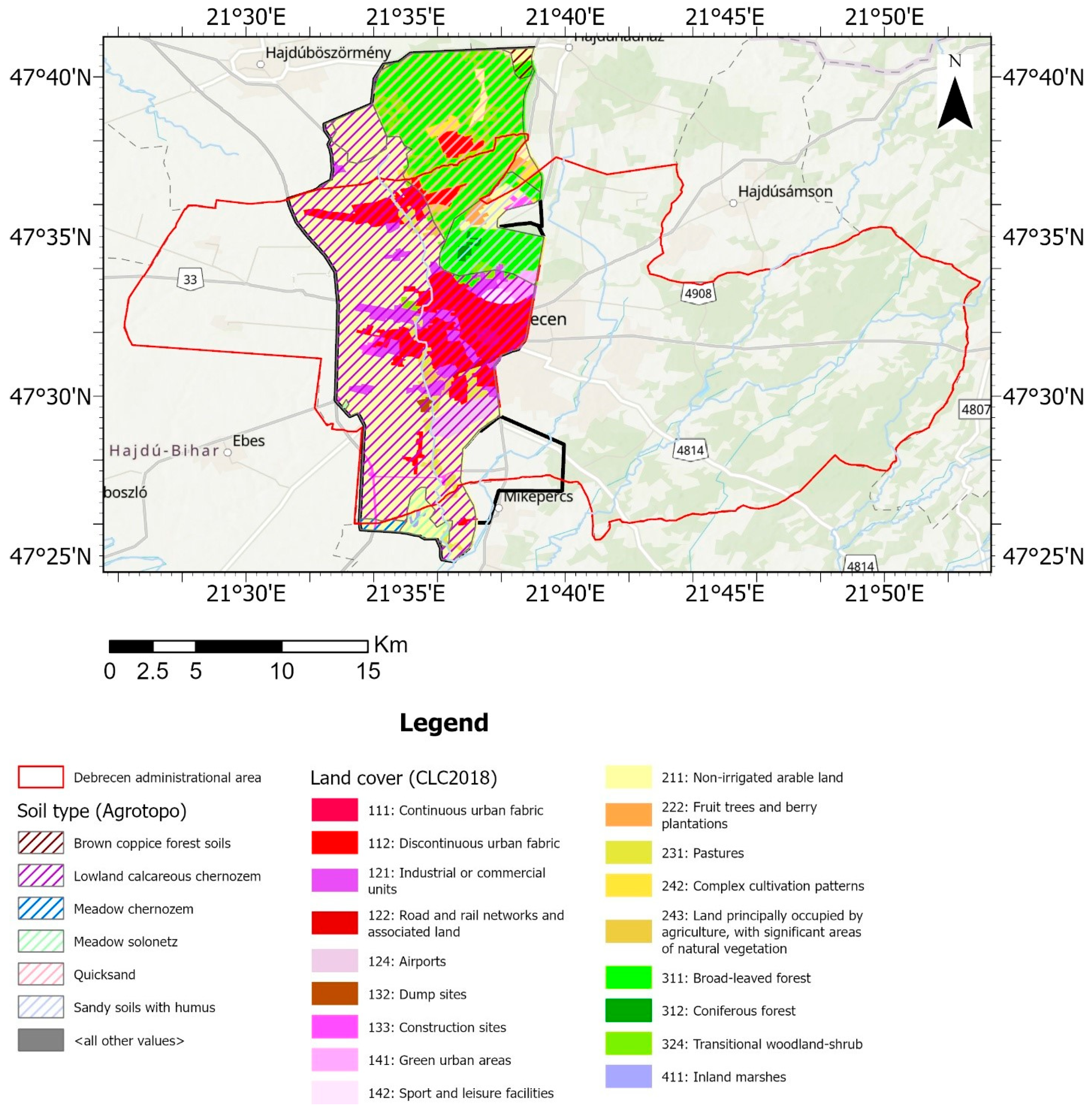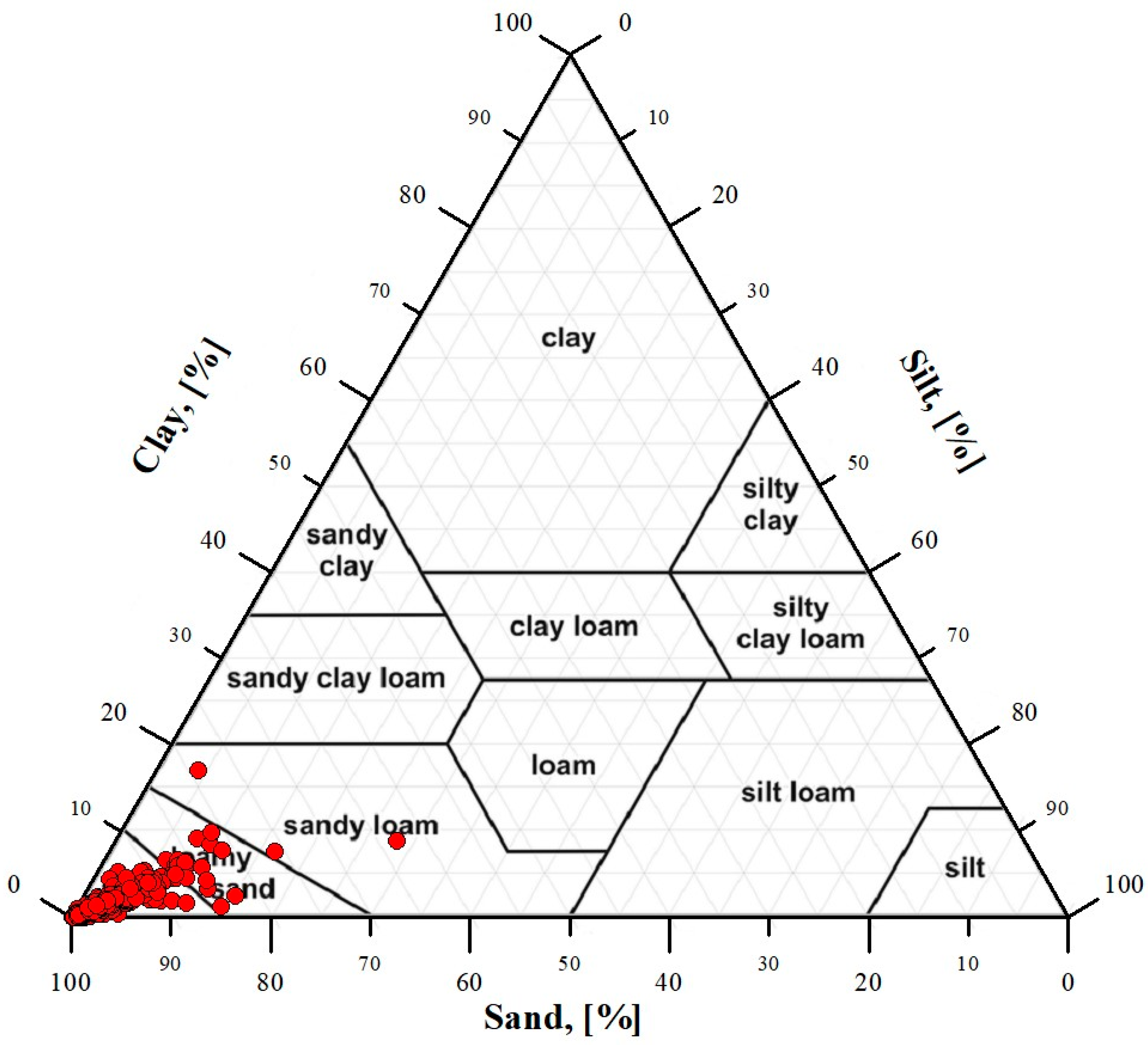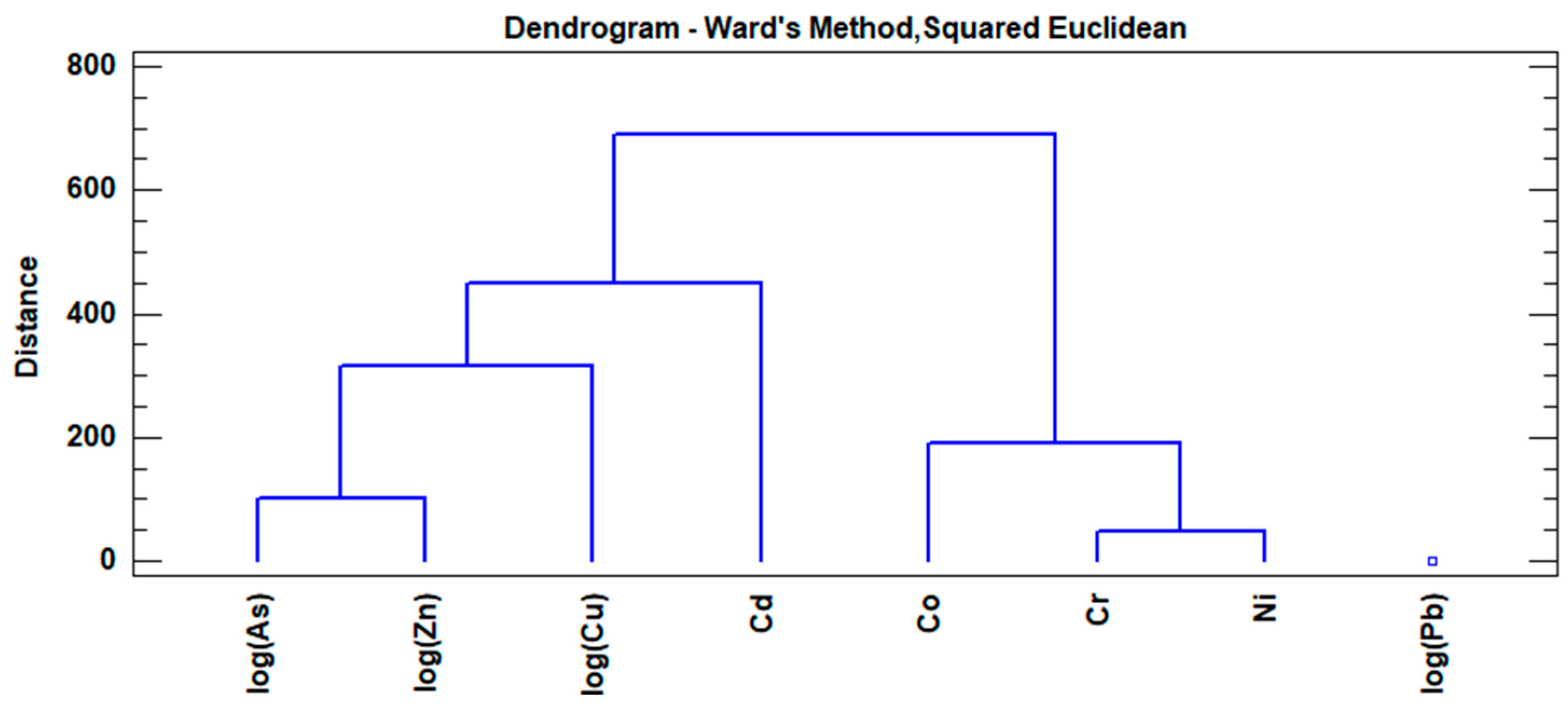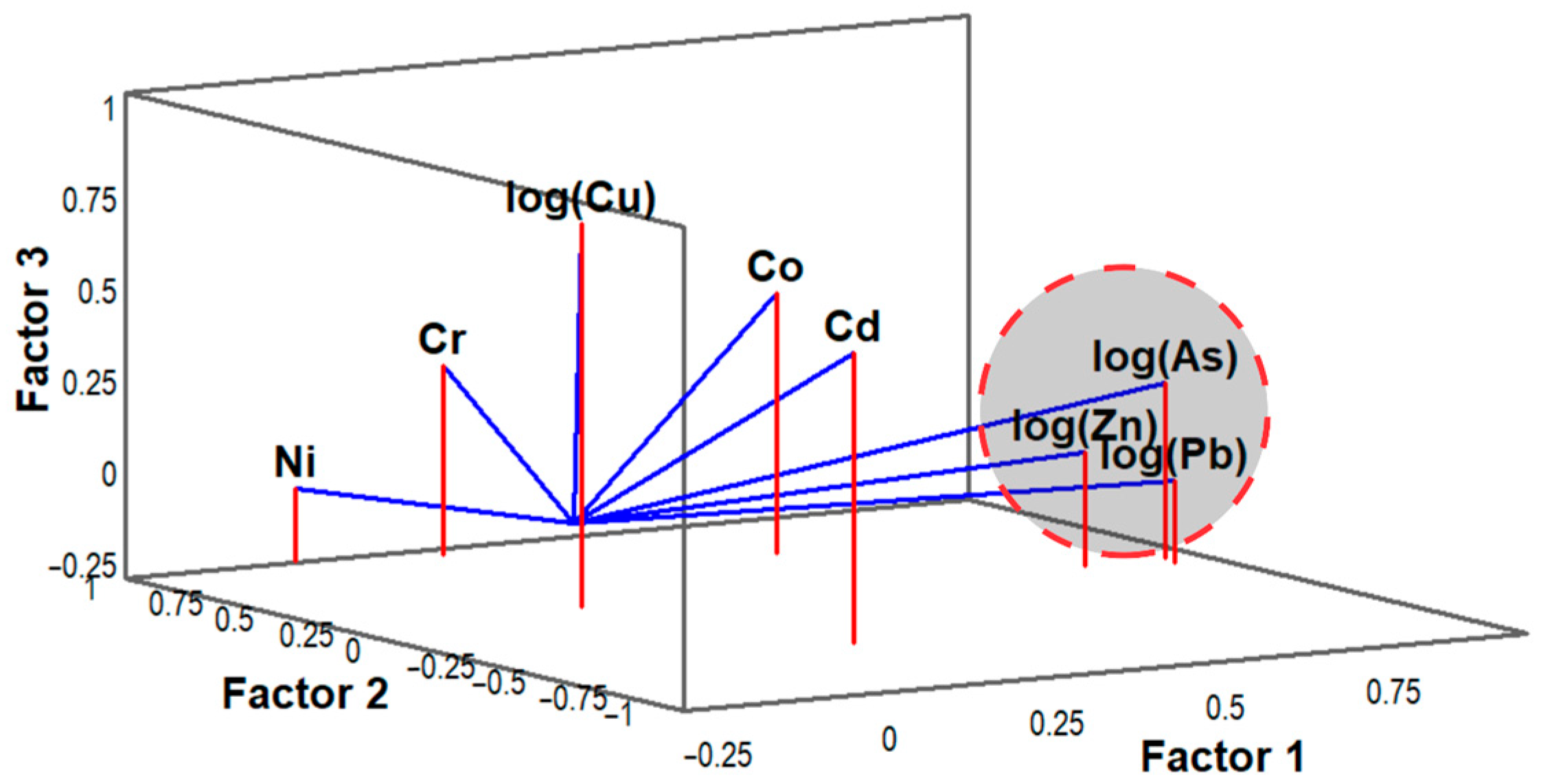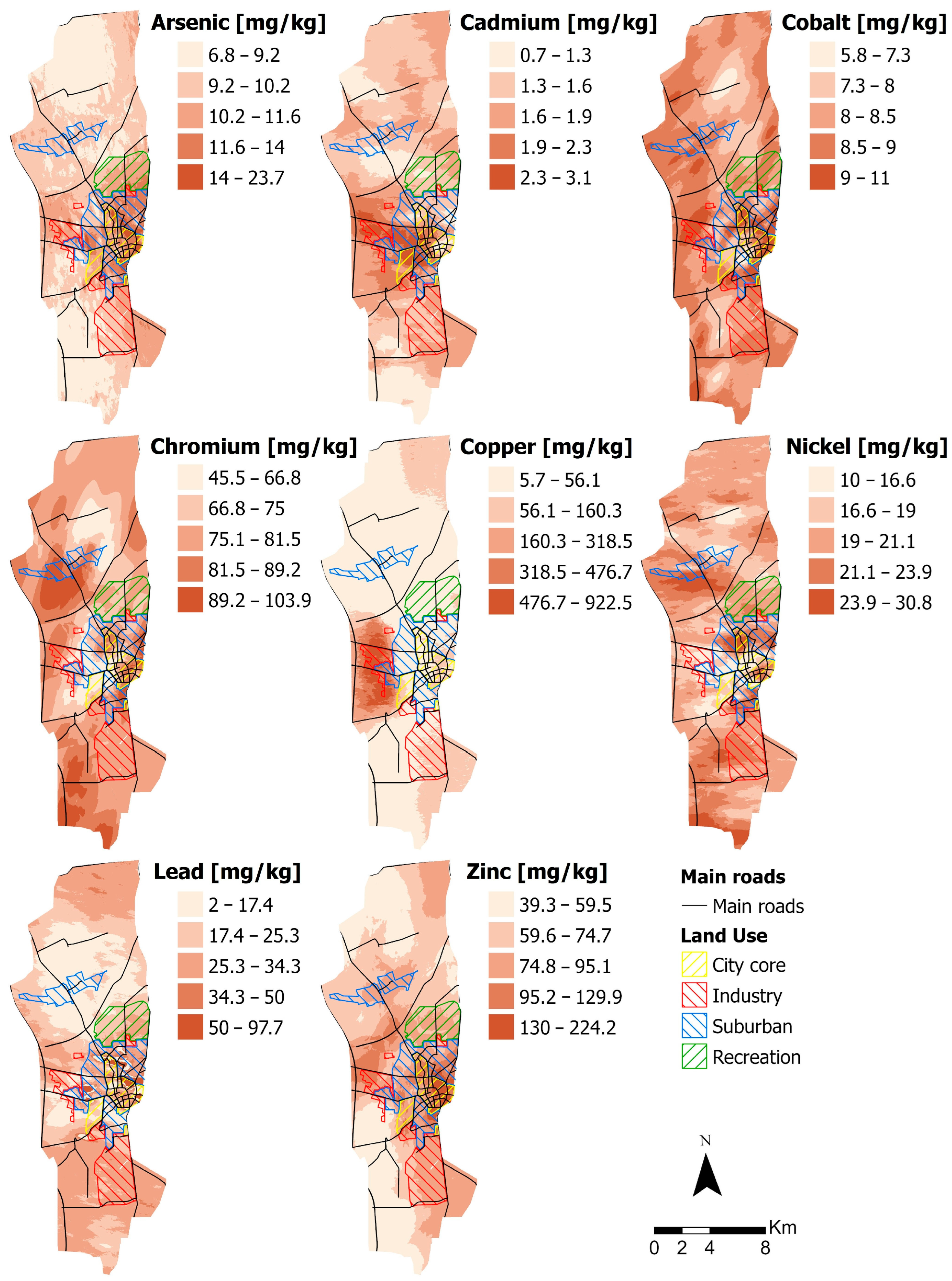3.1. General Physical and Chemical Properties of the Soils
The most important analytical parameters of soil samples from each sampling point were determined (
Table 3). Due to the large number of soil samples, only the statistically summarized data are displayed.
Particle size analysis confirmed a predominantly sandy texture with an average sand content of 94.9% (range: 62.9–99.9%). The silt and clay contents were significantly lower, with averages of 3.3% and 1.9%, respectively. The high variability in the silt (RSD = 26.1%) and clay (RSD = 25.6%) fractions suggests localized inputs of finer particles, possibly from atmospheric deposition, construction materials, or varying parent materials. The studied area is characterized by loess formation.
According to the USDA classification, soils predominantly fall into sand and loamy sand categories (
Figure 3), which is consistent with the observed dominance of coarse particles. Such textures are typical of disturbed or artificially reworked urban soils, often characterized by low water and nutrient retention capacity.
Bulk density values ranged from 1.3 to 1.6 g cm
−3, with an average of 1.5 g cm
−3, which is typical for soil types in this region [
21]. This range reflects varying compaction levels, from very loose zones (e.g., in areas with high organic content or landscaping) to more compacted zones (e.g., walkways or traffic-affected sites). The RSD of 11.4% supports this interpretation of mechanical variability in urban topsoil compaction.
The porosity estimates ranged from 36% to 38.4%, with an average of 36.9% and very low RSD of 0.5%. This consistency suggests a relatively uniform pore space distribution, possibly due to the dominance of sandy particles and shallow sampling depth, which limits natural stratification. Consequently, the vertical mobility of the topsoil layer was pronounced; the sorption ability was expected to be weak due to the lack of clay minerals in the investigated soils that otherwise would be able to adsorb positively charged ions such as heavy metals. Therefore, this area is highly sensitive to the vertical movement of different heavy metals, which affects the migration of pollutants [
33].
The pH values of the KCl solution ranged from 6.03 to 7.52, with a mean of 6.70, and a relatively low standard deviation (SD = 0.30; RSD = 4.48%), indicating that the soils were mildly acidic to neutral. Such near-neutral values are typical of the soil types found in this region.
The calcium carbonate (CaCO3) content was uniformly low, ranging from 0.1% to 1.2%, with an average of 0.3%. Such minimal carbonate levels indicate decalcified surface horizons, which are typical of urban soils that have undergone leaching or mechanical disturbances. The low variability (RSD = 6.7%) reflects the consistent depletion of carbonates across the sampled sites.
The organic matter (OM) content showed a wider variability, with values ranging from 0.4% to 1.9% and a mean of 1.6%. The relative standard deviation (RSD = 13.4%) indicates heterogeneous organic enrichment, potentially influenced by varying land cover types, vegetation, waste deposition, or localized management practices typical of urban zones [
34].
3.2. Exploratory Analysis of Heavy Metal Contaimnation
The concentrations of eight heavy metals commonly found in urban soils were analyzed using a dataset of 295 surface soil samples. The results, summarized in
Table 4, include descriptive statistics such as medians, trimmed means, standard deviations, and coefficients of variation.
Additional comparisons were made with data from other European urban environments [
18,
19,
49] to place the results from Debrecen in a broader geographical context.
In descending order of median concentrations, the elements were: Zn (78.1 mg kg
−1) > Cr (77.7 mg kg
−1) > Cu (29.9 mg kg
−1) > Pb (23.5 > Ni (19.5 mg kg
−1) > As (9.75 mg kg
−1) > Co (8.47 mg kg
−1) > Cd (1.64 mg kg
−1). Histograms of heavy metal concentrations (
Figure 4) showed non-normal distributions for most elements with pronounced right skewness, except for Cr, and possibly Co, which were closer to normality. The log-normal pattern observed for Cu, Pb, Zn, and Cd is typical in environmental geochemistry, where a few samples exhibit unusually high values, whereas most remain near the background levels.
Notably, zinc exhibited the highest median concentration among the analyzed elements. Although it remains below the Dutch intervention threshold, elevated levels are concentrated in the western–central part of the city, likely associated with long-standing and ongoing industrial operations, indicating a persistent localized source of contamination.
Cu and Zn displayed significant variation, with extreme values observed at certain locations. Cu concentrations ranged from 4.51 to 1030 mg kg
−1, with a very high standard deviation of 154 mg kg
−1 and an RSD of 171.1%. Zn levels ranged from 12.62 to 769.4 mg kg
−1, also showing substantial variability (RSD = 85%). Extremely skewed distributions (standardized skewness: Cu = 20.33; Zn = 22.12) and high kurtosis values confirmed the presence of extreme outliers. These patterns indicate localized anthropogenic enrichment, which is most plausibly associated with traffic hubs, industrial emissions, and construction-related surface deposition. The pronounced variations in copper and zinc concentrations are clearly attributable to localized point sources (see industrial zone marked as B in
Figure 1). This area, formerly used as a landfill and currently occupied by metal-processing facilities, exhibited exceptionally high levels of both elements. In contrast, within the remaining parts of the study area, the concentrations of both elements remained below the regulatory limit values.
Lead (Pb) showed a median of 23.5 mg kg
−1, which is considerably lower than values reported for other central European cities (e.g., Novi Sad: 82.3 mg kg
−1; Belgrade: 298.6 mg kg
−1) [
19,
30]. Although the maximum Pb concentration of 181.1 mg kg
−1 remained below the Dutch intervention threshold (530 mg kg
−1), the strong positive skewness (9.34) and high kurtosis (7.9) suggest localized contamination. Lead showed a spatial distribution similar to that of zinc, with the highest concentrations in industrial zone B and the densely populated city center. These hotspots likely reflect traffic emissions, metal-processing activities, and the legacy of former landfilling. In urban soils, Pb levels are thus shaped by the combined effects of historical contamination (leaded fuel, paints, industry) and present-day diffuse sources (traffic dust, demolition activities, waste).
The highest cadmium loads were also detected in the densely populated city center and in the nearby industrial zones (
Figure 1). Cadmium (Cd) concentrations had a median of 1.64 mg kg
−1, exceeding both Hungarian (1 mg kg
−1) and Dutch (0.8 mg kg
−1) target values in many samples. Although the maximum concentrations remained below the intervention thresholds, the combination of elevated means and a sharp right-skew (skewness = 7.85) suggests anthropogenic input, possibly from waste or atmospheric deposition and traffic (
Figure 4).
The arsenic (As), nickel (Ni), cobalt (Co), and chromium (Cr) concentrations generally remained within acceptable limits. The highest arsenic levels were measured in the northern part of the city, near the pharmaceutical factory. Arsenic showed a median concentration of 9.75 mg kg−1, well below the threshold range of 15–20 mg kg−1. Cobalt (8.47 mg kg−1) and nickel (19.5 mg kg−1) exhibited moderate variability, with relative standard deviations of 26.6% and 50.9%, respectively, and no evidence of significant anthropogenic enrichment.
A summary of relevant values in the literature for metal concentrations in urban soils across Europe is presented in
Table 5.
Compared to these reference cities, the results from Debrecen show that Cu, Pb, and Zn concentrations are generally lower than the averages reported for major urban centers, including Budapest, Torino, and Belgrade. In Serbia, leaded fuels were produced and sold for general use until 2010, while in Hungary the fuels were sold until 2004.
In contrast, cobalt and nickel levels in Debrecen were somewhat higher than the average values documented across major cities in a study by [
4]. This may reflect regional differences in the parent material or historical land use.
Among the western Balkan capitals, the values measured in Debrecen most closely resemble those reported for Ljubljana [
15,
49]. Notably, in cities with historically intense traffic, such as Belgrade, significantly elevated Pb concentrations were observed [
50]. This was largely attributed to traffic emissions, particularly the historic use of leaded petrol, which remained in use in Serbia at the time of soil sampling.
A comparison of regional background values and global soil averages (
Table 5) indicates that urban soils in Debrecen are affected by moderate enrichment of typical “urban” metals such as Cu, Pb, Zn, and Cd. While the contamination levels are not as extreme as in some other European metropolises, the presence of outliers and high variability in certain elements underscores the influence of localized anthropogenic inputs. These findings are consistent with observations across many European cities, where historical and ongoing urban activities have led to spatially heterogeneous metal accumulation in the surface soils [
17].
3.3. Multivariate Assessment of Heavy Metal Contamination
Factor analysis (FA) and linear discriminant analysis (LDA) require approximately symmetric data distributions for meaningful interpretation. Copper (Cu), zinc (Zn), lead (Pb), and cadmium (Cd) were log-transformed to stabilize variance and align the data structure (
Figure 5).
Spearman’s correlation analysis was then used to explore potential co-behavior and common sources among heavy metals (
Table 6). Although robust to non-normality, applying consistent data transformations facilitates interpretability across statistical approaches. This analysis revealed two dominant clusters of elements with distinct geochemical signatures, thereby suggesting different sources of contamination.
To further support the grouping patterns, hierarchical clustering was performed using Ward’s method with Euclidean distance, revealing similar associations among the elements (
Figure 6).
The first group includes arsenic (As), cobalt (Co), lead (Pb), and zinc (Zn). These elements were intercorrelated with coefficients, such as As–Pb (r = 0.72), As–Zn (r = 0.72), Pb–Zn (r = 0.47), and As–Co (r = 0.57), indicating a high degree of co-occurrence. This cluster is most likely linked to anthropogenic sources, particularly those associated with urban environments, including the historical use of leaded petrol, vehicular emissions, building materials, and the atmospheric deposition of metal-rich dust. The simultaneous enrichment of Pb and Zn in urban surface soils is well-documented in European cities, whereas As and Co are often associated with long-term diffuse pollution from traffic, fuel combustion, and possibly agrochemical residues [
15,
49]. The second cluster consisted of nickel (Ni), cadmium (Cd), and chromium (Cr). These elements showed moderate to strong correlations, including Cr–Ni (r = 0.70) and Cd–Ni (r = −0.58). Although the Cd–Ni relationship was negative, it still suggested a shared but inversely varying pattern, potentially reflecting competition for uptake or contrasting local sources. The Cr–Ni linkage is geochemically plausible, because both elements are commonly associated with ultramafic and alluvial parent materials. Thus, this second cluster is interpreted as being more strongly controlled by natural geogenic factors such as soil mineralogy and the composition of the underlying sediment.
Interestingly, Cu did not show strong correlations with either cluster, which could be attributed to its highly skewed distribution (
Figure 5 and
Figure 6) and the presence of extreme outliers. This may indicate multiple overlapping sources of Cu such as mechanical wear, industrial inputs, and localized hotspots unrelated to the broader geochemical background.
In summary, the correlation structure supports the distinction between anthropogenic clusters (As, Co, Pb, and Zn) and natural or mixed-origin clusters (Ni, Cd, and Cr).
3.4. Factor Analysis
Factor analysis (FA) was applied to the standardized dataset to identify common patterns and underlying factors in the urban soils of Debrecen. The analysis aimed to group variables with similar spatial behavior and potentially common sources, reducing dimensionality while preserving most of the variance in the dataset.
The Kaiser–Meyer–Olkin (KMO) measure of sampling adequacy was 0.618, indicating that the data structure was appropriate for factor analysis. Bartlett’s test of sphericity confirmed the suitability of the data for factor analysis (chi-square = 416.463, p < 0.001), suggesting significant correlations among the variables.
Three factors with eigenvalues greater than one were extracted, jointly explaining 73.40% of the total variance in the dataset (
Table 7). The first factor accounted for 34.99% of the variance, while the second explained 25.85% and the third contributed 12.55%. The factor loadings after standardization are shown in
Figure 7.
Factor 1 was characterized by high positive loadings for log(As) (0.885), log(Pb) (0.876), log(Zn) (0.770), and Co (0.492), clearly indicating a group of elements associated with anthropogenic activities, especially urban pollution. These elements are commonly found in areas with high traffic density, historical industrial use, and intense infrastructure development. The presence of Co in this component may reflect mixed inputs in urban environments, although sometimes of natural origin (
Table 8).
Factor 2 showed strong loadings for Ni (0.919) and Cr (0.826), which are typically regarded as indicators of natural geogenic sources, likely reflecting the mineralogical composition of the alluvial parent material in Debrecen’s soils. This grouping aligns well with the second cluster, identified earlier in the correlation analysis. Cd loaded negatively on Factor 2 (−0.614); its moderate contribution suggests a more complex source or behavior that may be partially influenced by both lithogenic and anthropogenic factors.
In contrast, log(Cu) was not strongly associated with any of the two main components. Instead, it loaded most heavily on Factor 3 (0.799), suggesting a distinct behavior that may reflect localized or point-source pollution such as construction debris, vehicular wear, or occasional industrial input. The weak correlation with the main anthropogenic clusters also supports this interpretation.

